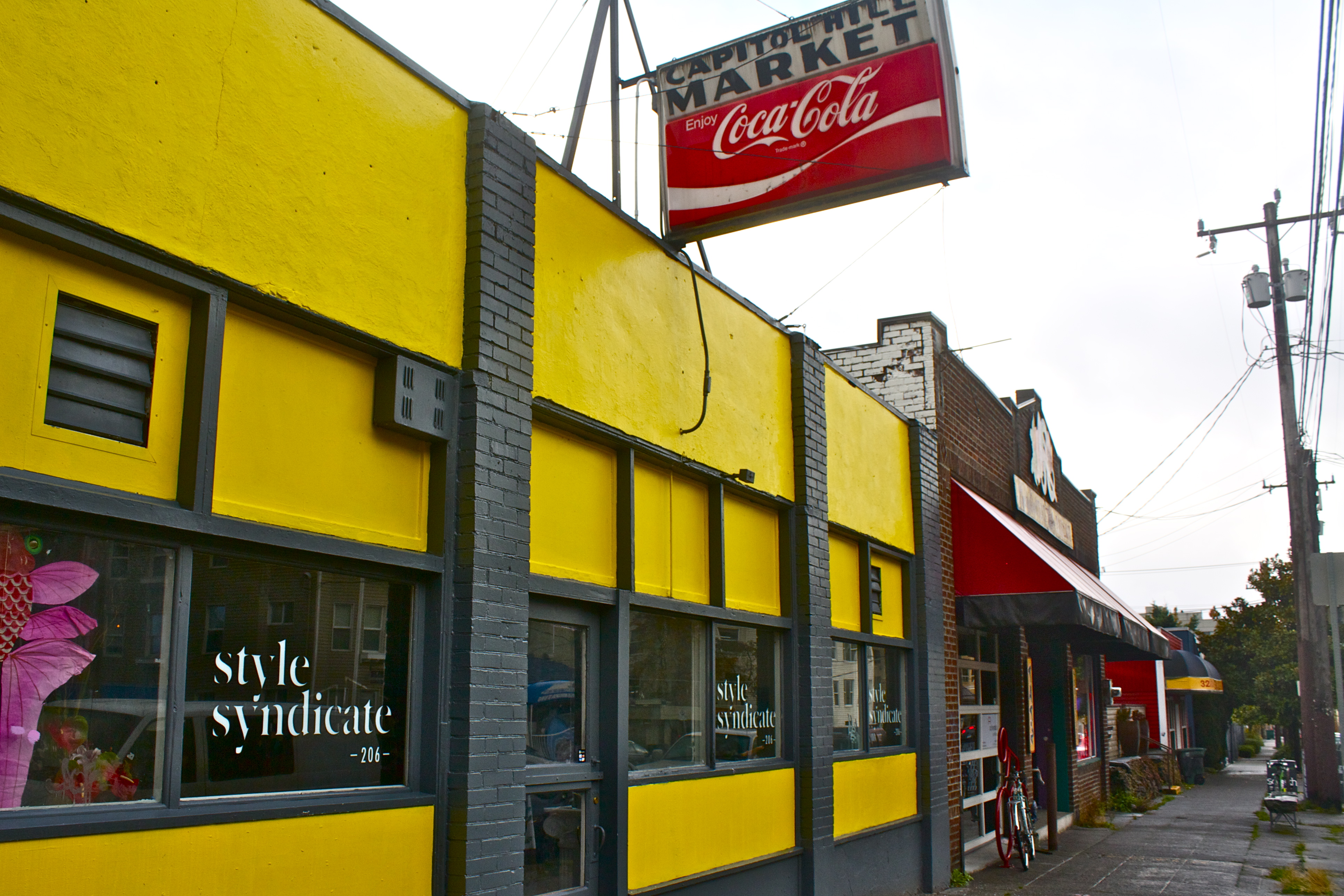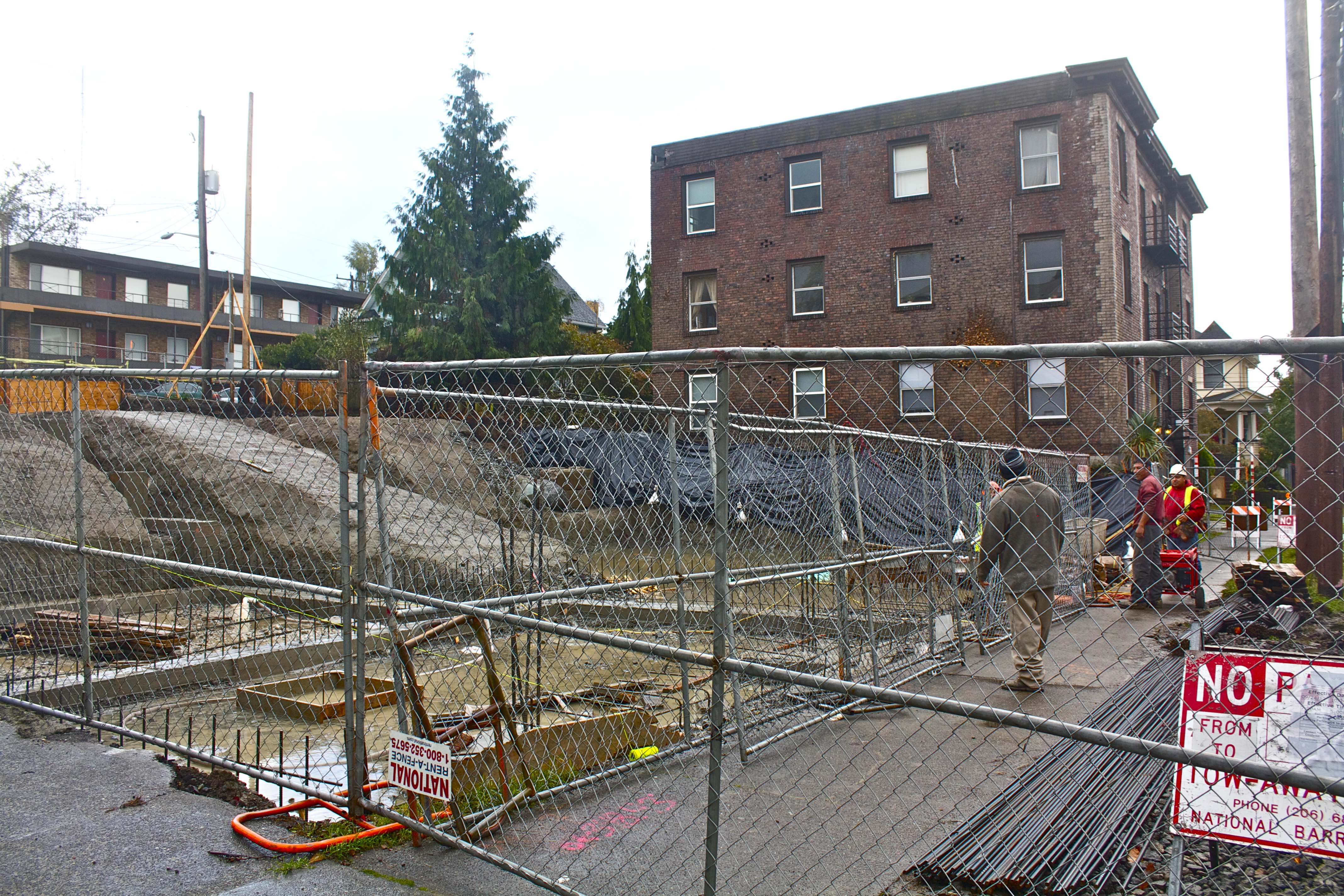 Was a market. Now a boutique. Soon, microhousing (Image: CHS)
Was a market. Now a boutique. Soon, microhousing (Image: CHS)
CHS has learned of a planned 12th Ave project that might throw some of the anti-microhousing opponents for a loop. Turns out, the developer behind one of the most highly regarded projects on Capitol Hill is also busy pulling together the pieces to create new microapartments on Capitol Hill.
“We’re creating a safe, affordable place for working people to live in our community with easy access to transportation,” Scott Shapiro tells CHS.
Earlier this month, King County records show that Shapiro paid $675,000 for the land where the old Capitol Hill Market stands near 12th and Howell for “CONSTRUCTION OF MIXED USE BUILDING CONTAINING Boarding Houses commercial,” according to the preliminary filing with the city for the project.
Last week, the Capitol Hill Community Council voted in a landslide of approval to pass a resolution calling on the City Council to enact an emergency moratorium on microhousing development. Community members object to loopholes that allow the projects to skip past the city’s design and environmental review thresholds.
Some, when it comes down to it, also object to the crawl of lowrise zoning that allows the spread of multistory buildings across Capitol Hill and the potential draw for developers looking to make a buck with low-quality construction and a transient tenant base. CHS has reported on the group Reasonable Density Seattle’s efforts to bring attention — and they hope action — to the loopholes.
One look at the city’s database of active “boarding house” style projects will show you why there is so much attention on the situation on Capitol Hill. CHS recently mapped 15 different projects around the neighborhood. We’ve added three since. With an explosion of transportation investment and a central city location, Capitol Hill is clearly the center of Seattle’s microhousing boom.
On 12th Ave, Shapiro’s project is part of at least three aPodment-style projects underway. Zoned for multistory residential buildings, the street is also active with standard-style apartment development, a cohousing project and Capitol Hill Housing’s 12th Ave Arts mixed-use project that will replace the East Precinct’s parking lot.
We reported last week that the old Capitol Hill Market space is providing a home for new fashion boutique Style Syndicate.
Retail is also part of the plan in the new development, Shapiro says. Quality is also part of the plan.
“We build things for the long term,” the developer said. “We think like a longterm owner. We want them to last.”
Shapiro said that the fact that the projects are small apartment buildings means that most of the development activity in the space is small scale and local.
 Another microapartment project near Shapiro’s newly acquired property (Image: CHS)
Another microapartment project near Shapiro’s newly acquired property (Image: CHS)
“These are small projects, and they’re done by small, local developers,” he said.
Shapiro’s presence in the microhousing mix might confound some arguments about the projects. He teamed up with Capitol Hill architect and developer Liz Dunn to create the Melrose Market project which celebrated its third anniversary this summer. His involvement in a project utilizing DPD director’s rule 6-2012 for boarding houses could add legitimacy to a development space that has created distrust for some in the community as projects move forward with little public notice.
Little discussed outside of the development community, DPD director’s rule 6-2012 might also provide an added level of comfort for those worried about the impacts of a microapartment building in their neighborhood. Drafted this summer, the six-page document lays out rules for construction, environmental and fire safety standards required for boarding house-style developments. While it doesn’t add the structure of design review and environmental review that many are calling for, the document does guarantee a framework for creating aPodments that meet important safety standards.
As for a moratorium, the Seattle City Council seems unlikely, at this time, to take such a drastic step.
“We are continuing to monitor it and will be meeting with DPD to review their analysis of the situation,” planning and land use committee head Richard Conlin tells CHS. “Generally, the experience has been that these projects do not seem to have much of an impact on the community, but they are clearly in a gray area of the code and we are trying to think about how to be proactive in allowing them but putting any needed parameters around them that might be helpful in ensuring consistency with our land use planning.”
Conlin says there isn’t a specific plan yet on how to proceed but DPD is putting together some alternatives for moving the issue forward.
“There are no plans to do a moratorium at this point,” Conlin writes, “there would have to be more clear evidence of problems on the ground to justify that.”
Shapiro doesn’t think that evidence will outweigh the benefits. ![]()
“When I lived in NYC, I lived for four years in a small 300-square-foot studio. It worked great for where I was in my life in my twenties,” he said.”
“It perfectly suited what I needed at the time. There are not as many as those opportunities here.”



Surveying other cities; San Francisco, Chicago, New York, that are experimenting with microhousing, it is clear they are doing so within standard design and environmental review frameworks.
Seattle is NOT.
Why would we want to give a particular type of building special status?
Why wouldn’t we want consistency?
There is no logical justification for this, despite what Conlin says.
Even if one strongly disagrees with the position I have stated, continuation of this loophole will significantly erode good will and trust between residents and the city council and other entities.
This is just lazy.
Can someone explain why the new Apodments on summit are going for as much as $1250 and why are people paying that kind of money for something the size of a bedroom?
I am very disappointed in Mr. Conlin that he is not taking a more proactive and aggressive stance on microhousing. I guess he and the rest of the City Council will wait until there ARE obvious negatives for our neighborhood because of these things, and by that time it will be too late as many of them will already be built. Meanwhile, they are “monitoring” the situation….that isn’t very helpful.
At the VERY least, the loophole allowing developers to claim they are putting up a “6 unit boarding house,” whereas in fact the building will have 48 units, must be closed ASAP. Then, design review will be necessary and that will help.
If you think developers, local or not, are putting apodments up to altruistically provide lower cost housing, you are kidding yourself. They are doing it to make alot of money, pure and simple. Let’s see, monthly rent of at least $600 (many of the units more than that), times 48 units…..do the math….that’s ALOT of income for these fat cats.
And also….please explain how the building was allowed to tower over its immediate neighbors, blocking views and light, and way out of scale to its surroundings.
Richard Conlin and the rest of the Council will not have to deal with microhousing in their well-protected neighborhoods. Another reason for distric elections – the Councilmembers do not give a damn about what happens to Capitol Hill as long as they get their cut and the problems, the parking, etc stay away from their neighborhoods.
You said it exactly right! We need district elections ASAP.
Honest question: is there a difference in impact on the neighborhood between mini-apartments with single occupancy and regular apartments (or houses) where people have multiple roommates?
So the difference is the sheer number of people. Let’s say in a shared house you have 4 – 6 people living in a single family home. This does have an impact but it is absorbed relatively easily. With apodments, they tear the single family home down, and build a multi-story structure that houses, say, 40 – 60 people where 4 – 6 people used to live. Then add to that the fact that there are currently no limits on the number of microhousing developments. Suddenly a block that had 10 people living on it has 150 people or more – virtually overnight. All these numbers are estimates of course but if you take a look around I think you’ll see that I am not exaggerating. Even if only half those people have cars you start to see what the impact is not to mention increased demand on police and other services, etc.
[…] block. Nor are the developers behind the projects all mercenary types looking to pull a fast one. This coming 12th Ave project, for example, is backed by one of the creators of Melrose […]
[…] block. Nor are the developers behind the projects all mercenary types looking to pull a fast one. This coming 12th Ave project, for example, is backed by one of the creators of Melrose […]
[…] then, stop by Friday’s Night Market and do some shopping. In the offing — this microhousing project from one of the developers behind the Melrose […]
[…] of the Melrose Market, Shapiro talked with CHS about his foray into microhousing on 12th Ave here in this 2012 CHS post on his project. The ‘Microhousing Melrose Market’ — not its real name :) — should open by […]